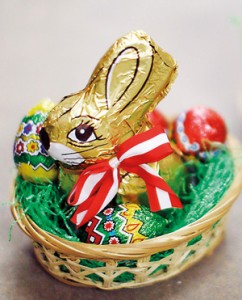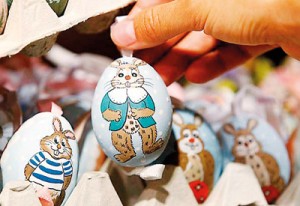Spirituality, spring and sweets:The origins of Easter traditions
View(s):Christians around the world celebrate Easter Sunday today, commemorating the resurrection of Jesus Christ from the dead. Easter is also linked to spring and here we look at the origin of some of those traditions associated with Easter.

Easter basket (Reuters)
Scholars believe the name Easter is derived from Eostre; the goddess of spring and renewal. The Christian customs linked to Easter eggs are to some extent adaptations of ancient pagan practices. The simple egg is the oldest and most universal symbol of new life. Cracked open, the empty shell resembles the empty tomb. Cute little bunnies, baby chicks are symbols of rebirth.
The tradition of decorating eggshell pre-dates Christianity. Ostrich eggs engraved with decoration some 60,000 years old have been found in Africa. Decorated ostrich eggs in gold and silver were commonly placed in graves of the ancient Sumerians and Egyptians as early as 5,000 years ago.
Later traditions saw them given as a token of love, friendship or good wishes. The first edible sweet eggs were made from sugar or marzipan some 100 years ago. Chocolate eggs are given to children on Easter Sunday. The largest Easter egg was over 25 feet high, weighed over 8,000 pounds and was built out of chocolate and marshmallow supported by an internal steel frame.
The bunny as an Easter symbol is related to have originated in Germany. The first edible Easter bunnies made out of pastry and sugar were made during the early 1800s. A common pastime during Easter is to find chocolate eggs hidden by the Easter rabbit or hare. Painting and decorating hardboiled eggs is also done during Easter time. The tradition of boiling eggs to prolong edibility led to the creation of the Spanish dish Hornazo (traditionally eaten on and around Easter) which has hard-boiled eggs as a primary ingredient. In Hungary, sliced eggs are added to potato casseroles around Easter.

Hand-painted Easter eggs (Reuters)
Still the spiritual significance of Easter is uppermost in everyone’s mind. Punshani Edirisinghe, a Catholic, describes the preparation for Easter as a process which begins with Ash Wednesday which is the start of the Lent- a 40 day period of repentance and sacrifice, where believers seek forgiveness for their sins through the sacrament of confession, fasting and giving it to the less privileged. “We participate in retreats to nourish our spiritual life and the way of the cross to recall Jesus’ journey to Calvary,” she said. At the end of the 40 days comes Palm Sunday which marks the beginning of the Holy Week where Holy Thursday, Good Friday and Holy Saturday are observed and on Easter Sunday, Christians celebrate the resurrection of Jesus.
It’s a day of celebration just like Christmas. Though Christmas is celebrated in a grander way, Easter is the most significant, says Punshani.
Adds Gihani De Silva, “The true meaning of Easter Sunday is that we celebrate the resurrection of Jesus Christ when He rose from the dead three days after dying on the cross.”


